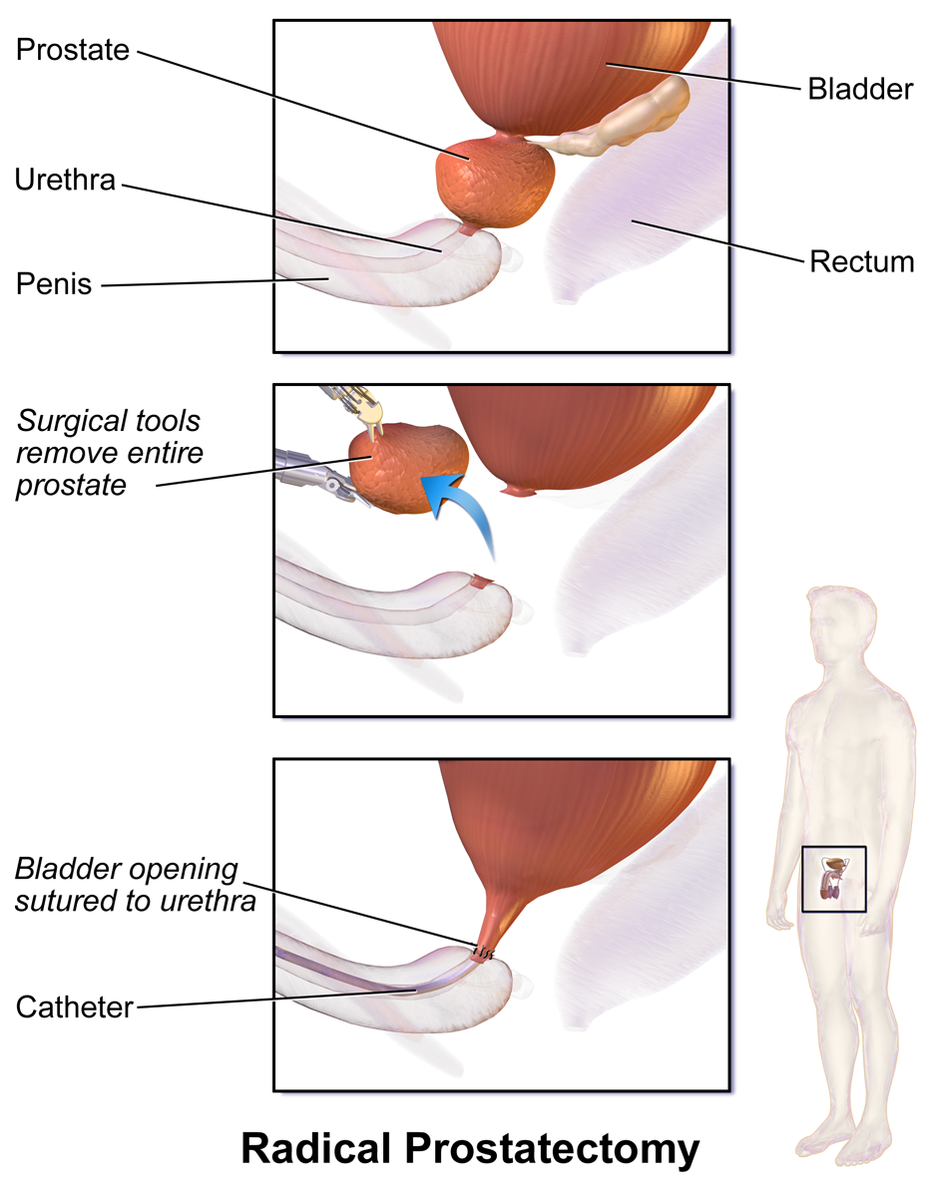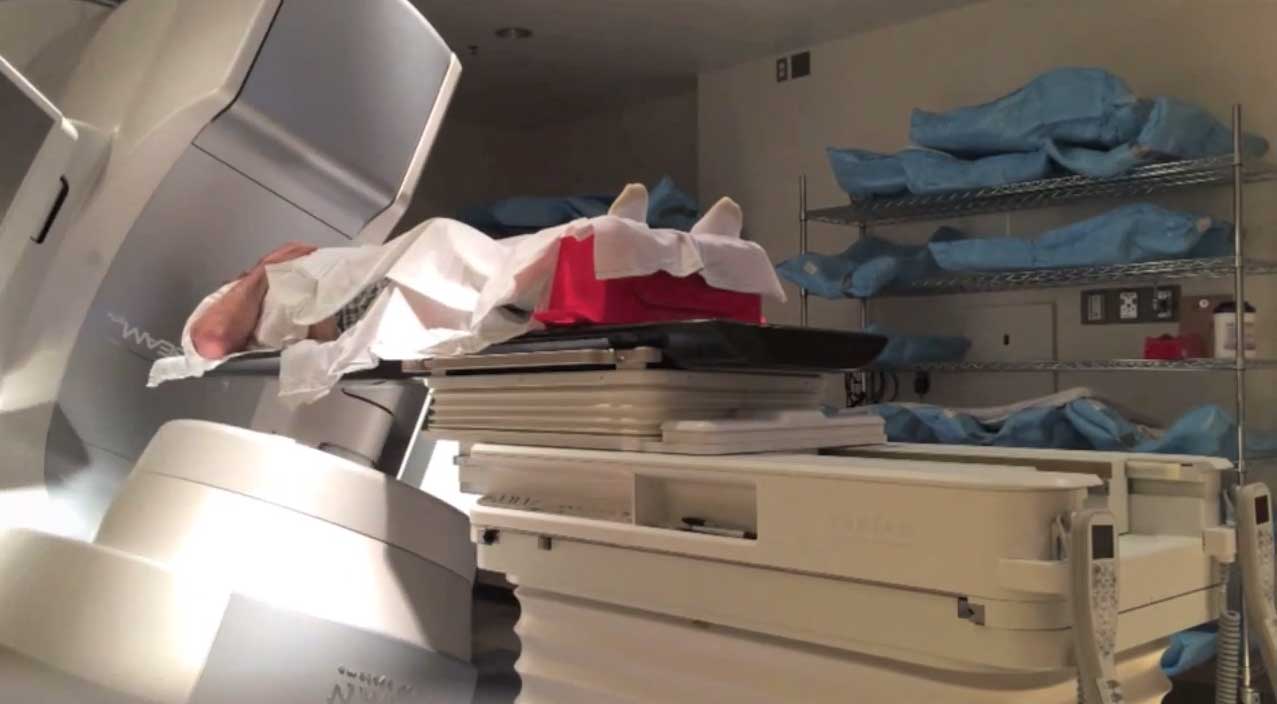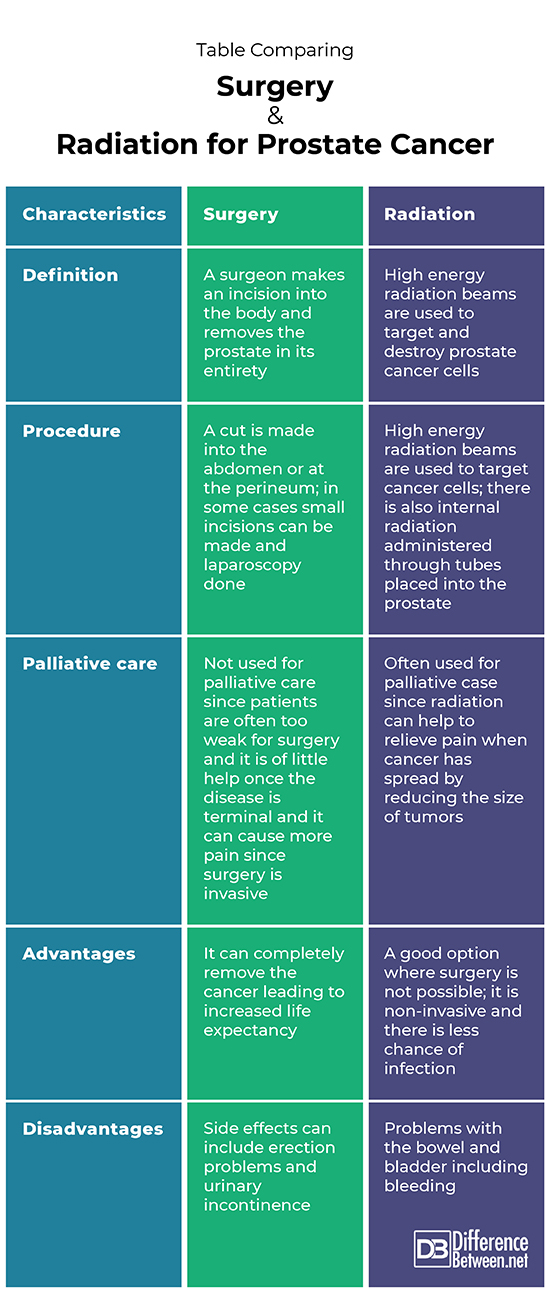Difference Between Surgery and Radiation for Prostate Cancer
Surgery for prostate cancer is when an incision is made, and the entire prostate gland is removed from the body.
Radiation for prostate cancer is when external or internal radiation is used as a treatment to kill prostate cancer cells.

What is Surgery for Prostate Cancer?
Surgery for Prostate Cancer (Definition):
Surgery for prostate cancer is when a surgeon makes an incision into the body and removes the prostate gland in its entirety.
Procedure:
Surgeons perform a radical prostatectomy in which the prostate gland is cut and removed from the body. Depending on the stage of cancer, nearby tissues as well as surrounding lymph nodes may also be removed, particularly if the concern is that the cancer has started to spread into nearby tissues. The surgery may be done using a laparoscope or, alternatively, the surgery is done through incisions made in the abdomen or perineum. Using the laparoscope is preferred if possible since it is less invasive, but it depends on the stage of cancer and extent of spread as to if this is a viable option.
Surgery for Prostate Cancer: Advantages
All of the cancer cells may be removed during the surgery, meaning that life expectancy greatly increases, particularly if the patient is in relatively good health. Surgical removal of the prostate does also increase survival times of patients who are considered high risk.
Surgery for Prostate Cancer : Disadvantages
There can be quite dramatic side effects of the surgery including bladder incontinence and also erectile dysfunction due to nerves being severed during the procedure. Since this is a surgical procedure there are other risks including the possibility of adverse reactions to the anesthesia, bleeding, and infection, as well as potential injury to any surrounding organs. The prostate also plays a role in semen production, which means men would not be able to father children after this surgery.

What is Radiation for Prostate Cancer?
Definition:
Radiation is a type of therapy in which high energy radiation beams are used to target and destroy prostate cancer cells.
Radiation for Prostate Cancer: Procedure
Radiation options include using an external beam or internal therapy. In general, radiation is often recommended for stage I and II prostate cancer patients, since the cancer grows very slowly. External beam radiation therapy is when beams are emitted outside the body and pass through the skin and into the organ. Internal radiation is a process called high dose-rate brachytherapy in which radiation is administered through tubes placed directly into the prostate gland. Patients who have high grade cancer often receive both treatments, internal and external radiation treatment.
Radiation for Prostate Cancer: Advantages
Radiation therapy is often recommended for early stage, stage I and II and as adjuvant therapy after surgery for stage III, and as palliative for stage IV to reduce pain. It is often a good choice where surgery cannot be done due to age or health status of the man. Radiation is a non-invasive procedure and so there are lower risks of complications such as bleeding and infection. This therapy can sometimes be used after surgery, along with hormone blockers, if signs indicate more cancer cells in the body.
Radiation for Prostate Cancer: Disadvantages
Side effects from treatment may include burning and even bleeding from the urinary tract and bowel issues including bleeding from the rectum and diarrhea.
Difference between Surgery and Radiation for Prostate Cancer?
Definition
Prostate surgery is when the prostate is cut out and completely removed from the body. Radiation for prostate surgery is when high energy beams are used to kill cancer cells.
Procedure
In the case of surgery, a cut is made into the abdomen or at the perineum; in some cases small incisions can be made and laparoscopy done. In the case of radiation therapy, high energy radiation beams are used to target cancer cells; there is also internal radiation, which is administered through tubes placed into the prostate.
Palliative care
Surgery for prostate cancer is not used for palliative care since patients are often too weak for surgery and it is of little help once the disease is terminal and it can cause more discomfort. Radiation is frequently used for palliative case since it can help to relieve pain when cancer has spread by reducing the size of tumors.
Advantages
With surgery for prostate cancer, the cancer can be completely removed and life expectancy increased. With radiation for cancer treatment, the advantage is it is not invasive and there is a reduced chance of infection.
Disadvantages
Side effects from surgery can include erection problems and urinary incontinence. Side effects from radiation therapy can include bladder and bowel problems, including diarrhea and bleeding.
Table comparing Surgery and Radiation for Prostate Cancer

Summary of Surgery Vs. Radiation for Prostate Cancer
- Both surgery and radiation can be used to treat patients who have prostate cancer.
- Surgery for prostate cancer is invasive but has the benefit of potentially completely removing the cancerous cells from the body.
- Radiation is a less invasive treatment for prostate cancer and also has the advantage of being helpful for patients needing palliative care.
- Difference Between Rumination and Regurgitation - June 13, 2024
- Difference Between Pyelectasis and Hydronephrosis - June 4, 2024
- Difference Between Cellulitis and Erysipelas - June 1, 2024
Search DifferenceBetween.net :
Leave a Response
References :
[0]Loeb, Stacy, et al. "What are the outcomes of radical prostatectomy for high-risk prostate cancer?." Urology 76.3 (2010): 710-714.
[1]Mark, J. Ryan "Prostate Cancer” MSD Manual, 2019, https://www.msdmanuals.com/professional/genitourinary-disorders/genitourinary-cancer/prostate-cancer#v1059972
[2]Shipley, William U., et al. "Radiation with or without antiandrogen therapy in recurrent prostate cancer." New England Journal of Medicine 376.5 (2017): 417-428.
[3]Image credit: https://www.google.com.ph/url?sa=i&url=https%3A%2F%2Fstanfordhealthcare.org%2Fstanford-health-care-now%2F2014%2Fradiation-therapy-for-prostate-cancer.html&psig=AOvVaw1phPPvB1xnv0cufMQCILzw&ust=1613117205895000&source=images&cd=vfe&ved=0CAIQjRxqFwoTCIiFgaOw4e4CFQAAAAAdAAAAABA7
[4]Image credit: https://commons.wikimedia.org/wiki/File:Prostate_Removal.png
